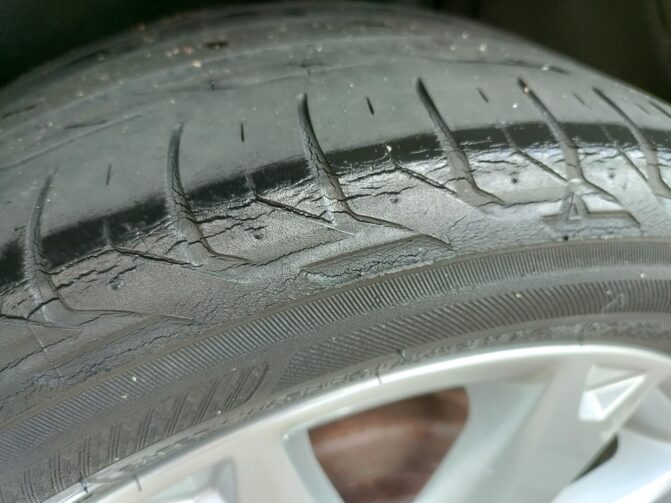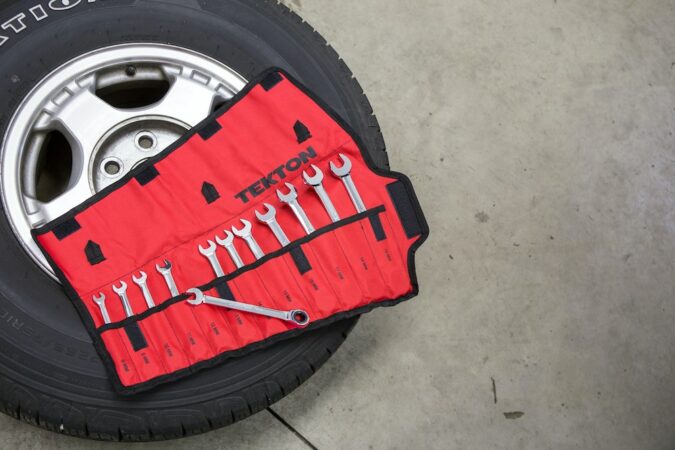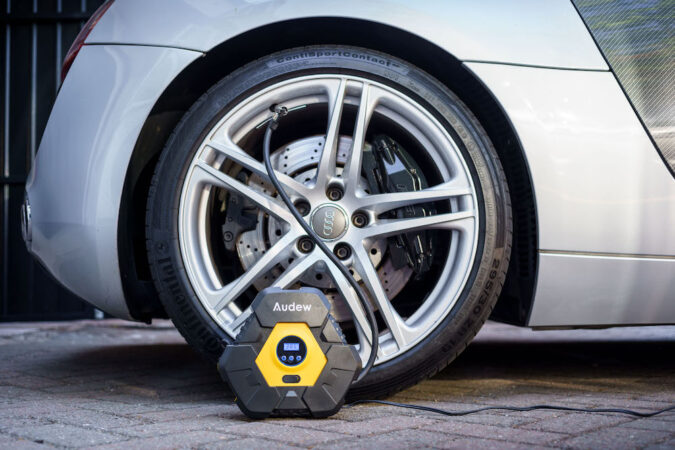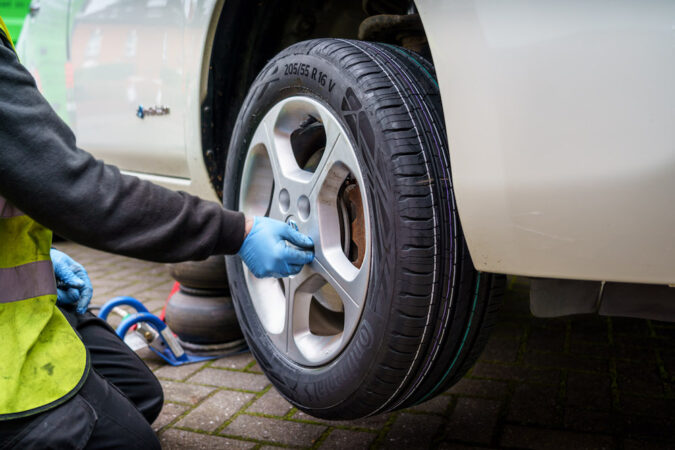You’re leaving work and approaching your car when suddenly you see a nail head in your tire. Driving with nail in tire is possible? Or there is a nail in the tire but not leaking air? Your tire could be losing air. Tires are one of a car’s most crucial components since, without them, a car won’t typically move. They protect your car’s wheels. They must be sturdy because they are designed to resist the worst conditions, just like the engine. Tires often have treads that give them a firm hold on the road.
It is common for your tires to run into sharp things like nails, tiny rocks, or screws while you are outside. Furthermore, as you are aware, in the worst-case scenarios, these sharp things may result in a tire blowout. Is it okay to drive while having a nail in your tire? There are two possible responses to this query: yes and no. This article attempts to explain why.
- What To Do?
- How to Identify Nails?
- Can it cause a Tire to Explode?
- What are the Risks?
- How to Fix a Flat Tire?
- What is the Cost?
- Precautions to Follow?
- FAQs
Nail In Tire What To Do
It can be difficult to determine whether your tire is in danger because sometimes you won’t even see a nail on it. You won’t notice a nail embedded on the tire until your tire goes flat or you take your automobile in for normal maintenance.
When you see the nail, don’t touch it since you might tamper with it by driving it farther into the tire, which could be dangerous. If you are close to a gas station, you can continue driving with the nail remaining on the tire and change the tire when you arrive. If you need roadside assistance but are distant from a station. You can call for it, and someone will come to you. Alternatively, if you have the proper tools in your trunk, you can change the tire on your own (and learn how to change a tire on a car).
The majority of folks now query whether you should fix or simply replace the tire. This solely depends on how much damage the nail has inflicted on the tire. The best course of action is to call a mechanic, who will then advise you on whether to replace or repair your tire based on the size and position of the hole.
A tire replacement is typically far more expensive than a nail in tire repair. The nail must be replaced if it is on the sidewall or the outside of the tire. You can simply plug or repair the tire if the hole is not detrimental, such as a nail in the tread of the tire. Due to the possibility of failure when traveling, this is not a long-term option. To be safe, you will eventually need to change your tires.
How To Identify A Nail In Your Tire
Additionally, if the hole left by the nail is smaller than a quarter of an inch, it can be repaired; however, if it is larger, you should replace the tire. Replace the tire when you discover that it has numerous, closely spaced nail holes. One or more punctures spaced 16 inches apart will be required for the repair.
Tires are prone to punctures. When they encounter these difficulties, they are quick to give up. Finding out whether a car tire is punctured or not is the simplest thing you can accomplish in a car, even if you’ve never driven one before.
There are a few additional factors needed to determine whether the puncture was intentional, including:
Driving With Nail In Tire Symptoms #1: Your Tire Pressure Is Dropping
Have you ever driven your tire into your driveway without incident, slept with it intact, and then awoke to find it had lost weight due to the surplus pressure a puncture had allowed to escape?
It’s possible that you went out to run at the usual speed without paying closer attention. Only to find that your car weighs more on one side than the other.
It is a painful experience requiring you to refill the tires with the necessary air pressure to repair them. It’s also apparent when the nail is on side of the tire. It demonstrates that the nail wasn’t a result of passing on the incorrect side of the road. It’s someone who wants to deliberately set you off in a rage.
Although excessive tire air loss won’t cause your car to shake when you reach 60 mph. That doesn’t mean you shouldn’t take the necessary action. It is said that a stitch in time saves nine.
Driving With Nail In Tire Symptoms #2: Having More Time For Tire Inspection
If you thoroughly inspect your tires, you will have the knowledge necessary to determine whether a nail has been repaired in one of them. Often, it’s a small nail or screw in the tire that’s hidden inside the fabric or within the thread; it doesn’t have to be a large nail staring at you. You need to inspect each end of your tire to detect this.
If you feel you need to do more checking, you can just have the tire loosened rather than conducting a thorough search that involves raising the car with a jack and rotating the wheel to check thoroughly for hidden nails in your vehicle.
Driving With Nail In Tire Symptoms #3: Spray Water On The Tire
Small nails are deceptive; because they cause the tire to lose air gradually, you won’t notice that there is one in your tire. Additionally, you must fix this as soon as you notice it. Although it won’t cost you anything immediately, ignoring it could worsen the tire’s impact.
Another method involves removing the tire after being raised with a jack and putting it in a container with clean water. You can use this to find the rim’s hidden pores. It will show locations where the tire is gradually losing air.
Can Driving With Nail In Tire Cause It To Explode
Yes, a tire can potentially explode if a nail is embedded within it. This increases the likelihood that a tire explosion will occur because you are unlikely to discover your tire has a nail. Your tire will still be damaged even if it doesn’t lose air pressure due to the nail puncture.
As a result, an explosion could happen if you are driving normally when one of your tires runs over a pothole or other rough patch of the road, increasing the tension on the tire. Driving at greater speeds on a highway can also create conditions that make a blowout possible because tires frequently explode when they overheat.
The more of your tire that touches the road when you’re driving means your tire is losing air, which is not ideal. Due to the higher friction caused by this, an explosion may occur when combined with shoulder and sidewall damage that may already be present.
In some instances, you could be fortunate enough to find out almost immediately if your tire has a nail in it. If you hear a clicking sound while driving that appears to be coming from outside the car, it is most likely coming from a nail in one of your tires.
Furthermore, if you hear or feel one of your tires thudding while driving, it may be a sign that a nail has punctured it, causing the tire to lose air. It is best to stop straight away if you encounter this so you can investigate.
In any other case, you can be driving on what is technically regarded as a flat tire if the nail causes your tire to continue to lose air until the pressure drops below 20 pounds per square inch.
The Risks Of Driving With Nail In Tire
The following factors determine whether a nail in your tire is safe or dangerous:
Driving With Nail In Tire Risks #1: It Might Lead To A Blowout
A blowout from a tire hole can damage your car and endanger your life, especially if it occurs while you are on the highway. This only occurs if the tire loses air pressure as quickly as possible due to the puncture.
In some instances, a nail will pierce a tire deeply, preventing air from escaping. Accidents cannot occur in situations like this since a blowout only occurs when the tire is fully flat due to a loss of air.
Driving With Nail In Tire Risks #2: It May End Up Costing You More Money
Don’t be one of those who wonder how long one can drive with a nail in the tire. Driving your automobile with a nail dangling inside the tire will seriously harm the tire and possibly render it irreparable.
There is a chance to get it fixed if you pull over to mend it rather than paying more to have it changed. Still, occasionally, some individuals prefer to start over, so they would rather buy a new tire than put themselves through the stress of patching a tire or attempting to determine which area of the tire is leaking.
Driving With Nail In Tire Risks #3: You May Injure Others
You shouldn’t disregard accidents. Injuries may result if you have people nearby when your tire blows out. You, and those close to you, are not safe. It is best to fix your tire as soon as you realize it isn’t fit for a journey. Make it easy on yourself by changing the tire or having it fixed by a professional.
Methods For Fixing A Flat Tire
Before pulling the nail out, rotate the tire and look at the tread to find it. If a large screw or bolt in the tire is poking out, it will usually be easy to identify; but if not, it is time to try alternative methods of locating the leak.
The simplest alternate way would be to spray the tire with a frothy liquid (like window cleaner), re-inflate the tire (ensure that you’re familiar with how to put air in tires at gas station), and then watch for bubbles created by the leaking air. This will make it clear where the leak is.
1. Remove The Screw Or Nail By Hand From The Tire
Use a drill or screwdriver to simply loosen the screw if it is one. Try to remove the object from the tire if it is a nail using a claw hammer, vice grips, or a set of pliers. Don’t be concerned if the tire flattens or makes a hissing sound; that’s just the air escaping.
2. Reaming The Hole
Once the nail or bolt in the tire has been removed, the hole must be reamed. The majority of tire plug kits include a tool with a file-type tool at the end. To rough out the hole, repeatedly insert and remove this tool from it.
3. Thread The Plug Tool And Insert The Tire Plug
After the hole has been reamed, another tool that resembles a needle will be visible. Crimp the end of your plug between the plug. You are now prepared to plug the hole permanently. Place your plug-threaded needle inside the opening. When only a small portion of the plug is left sticking out, firmly push it in.
The plug should remain in the hole, and you should be able to pull the plug tool out of the tire at that point. Trim the plug’s protruding end as close as you can to the tire. Another thing to remember is that it is not a good idea to patch or add additional plugs to a tire. A replacement tire should be purchased at that time if the tire has previously been patched once.
Nail In Tire Repair Cost?
The good news is that replacing the tire will probably just set you back a few bucks if the nail enters your tire closer to its center than its outer borders. When you bring your automobile to a repair shop, the mechanic will check your tire to ensure it can be fixed. If so, a patch will be placed over the puncture to seal the hole before the tire is taken from your car. An expert will probably just cost $10–$20 to complete this short repair.
You might want to keep in mind that most tire merchants will provide free nail in tire repair services if you can bring your vehicle to the tire dealer where you initially bought your tires and experienced a nail puncture.
Nevertheless, only try this if your tire dealer is close to where you are. Otherwise, you run the chance of going too far on a tire that might be seriously damaged, which could result in an accident.
How To Take Precautions
You should always be ready for any emergency because you never know when you’ll find yourself in one. In this situation, make sure a pressure gauge is constantly with you. This will make it easier for you to monitor the tire pressure.
To keep your tires inflated until you reach a gas station where you can fix or replace the tire, you might also require an air compressor. Knowing tire-changing techniques is advantageous when a nail is lodged in your car’s tire.
You could always do it yourself to save time and money. Additionally, you should regularly check your car’s tires for any unexpected items before you drive. Avoiding places like building sites where nails are likely to be present is also essential. Avoid driving through such areas as your tires will quickly and unknowingly pick up nails.
FAQs:
Can I Drive On A Flat Tire
To put it briefly, you cannot drive with a flat tire. Although you might be tempted to limp your tire to the shop for repair, you cannot drive if your tire is flat. The problems with vehicle safety and control that might result from low tire pressure while driving can also result from a flat tire, but their likelihood and effects are much greater.
How Long Can You Drive With Low Tire Pressure
Low tire pressure warnings should not be used for lengthy or distant drives. When your tires are underinflated, you shouldn’t travel more than 50 miles or for more than an hour on paved roads under perfect circumstances.
Can You Drive With A Nail In Your Tire
Yes, you can drive with a nail in your tire. Drivers frequently drive over nails without realizing it. Nails can snag a tire so firmly that air cannot escape; the car may strike the nail so quickly and forcefully that air is never given the chance to escape. When this occurs, drivers will not discover the nail until the car is in for another type of treatment, such as a tune-up or tire replacement.
How Long Can You Drive On A Tire With Fix A Flat
It is advised only to use Fix-a-Flat as a short-term fix to regain road mobility because it does not fill the tire correctly in the same manner that a pump would. According to the manufacturer, driving on Fix-a-Flat is advised for three days or 100 miles, whichever comes first.
What Happens If You Drive On A Flat Tire
Driving with a flat tire not only makes it dangerously harder for your car to handle, but it may also harm the wheel, brakes, alignment, and perhaps other parts like the suspension and steering system.
How To Fix A Nail In Tire
Use a pair of pliers to get rid of the nail once you’ve used it to locate the spot where the tire was punctured. Once the nail has been removed, use the reamer (or another tool provided) to make the pierced area larger. Enlarging the hole can seem absurd, but we assure you it is vital. Threading the plug into the hole is done using the installer and plug. Finally, you have now plugged your tire! You can then proceed to drive after inflating the tire to the recommended PSI.
Why Does My Tire Keep Going Flat
Tires can crack as their rubber deteriorates from aging, environmental exposure, or a combination of the two. As a result, tire defects can be challenging to find and fix, resulting in gradual leaks, frequent flats, and even blowouts.
How Long Can A Car Sit On A Flat Tire
The maximum amount of time you should leave your car parked in a flat is roughly twenty-four hours. The likelihood of a tire being damaged increases significantly after twenty-four hours. Driving with a flat tire is also not advised. It is exceedingly risky to drive with a flat tire; at worst, it can result in an accident.
Can I Drive Long Distance With A Plugged Tire
Numerous investigations have found that 8 miles are the limit for driving on a plugged tire. Although it keeps the wheel turning while searching for a service center, plugging is not a long-term solution.
How To Puncture A Tire
You must use a sharp knife in place of a regular kitchen knife to quickly slice a tire. If used with enough effort, a knife can very simply puncture the rubber surface. The tire will go flat in a matter of seconds with a true knife slice.
Is It Bad To Drive On A Flat Tire
Driving on a flat tire may not appear to be a problem. Especially if you only travel a short distance to a repair shop. However, it is risky and can seriously harm your tire and your car to drive with a flat tire.
Can You Drive On A Flat Tire In An Emergency
Although it is possible to go 4 miles on a flat tire, this should only be done in an emergency. Driving on a flat tire stresses your wheel rims and could harm your suspension. If the automobile tire has been used for an extended period of time, it may not be possible to fix it.
Can You Drive With A Screw In Your Tire
The tire’s condition will determine whether or not you can continue using your vehicle if you see a screw in your tubeless tire. Your first task is to check if your tire still has air in it. The best course of action if your tire still has air in it is to drive to the closest auto shop or repair facility while leaving the screw in the tire.
Can You Repair A Tire With A Nail In The Sidewall
It is never advisable to repair nails in the sidewall of tire damage that extends to the threads because doing so weakens the tire’s entire construction. The unrepairable nail in the tire sidewall cannot be fixed if it has a bubble, and minor punctures should also not be patched. The only time a nail in the sidewall of tire damage can be repaired with glue is if it is a very little scrape that does not extend into the threads. In my opinion, you should never fix sidewall tire damage, especially if the scrape or damage is this small. There is also no sense in gluing it.
How Far Can You Drive On A Rim
Numerous factors, such as vehicle weight, wheel type, road characteristics, and vehicle speed, affect how far a person can go on a rim. A typical car can therefore travel from a few yards to a few miles. Despite the fact that it is not advised, driving on a rim can be bad for the car.
Why Can’t You Patch A Tire Shoulder
The cause is that only a small number of materials may adhere due to the thinness of its wall adherence. In more detail, a wheel’s structure will suffer severe harm from sidewall damage.
How Low Can A Tire Be Before It Is Unsafe
The lowest tire pressure that is generally regarded as safe for a car tire is 20 pounds per square inch (PSI). Any pressure below 20 PSI is considered a blowout and increases the likelihood of a potentially dangerous puncture for the vehicle.
How Do Nails Get In Tires
Nails typically lie flat over the rough street. Because of the power of friction, they roll up and are thrown when your front tires travel over them quickly. The friction force reverses your tires’ motion. The result is that the kicked-up nails are thrown in front of your back tires. Sadly, if the nails strike the back tire at the proper angle. The weight of the tire will force the nail into the tread of the tire. The tire doesn’t immediately pop, though. The nail penetrates the tire more deeply with each rotation.
How Long Does Fix A Flat Last For A Slow Leak
Yes, you can repair the slow leak in the tire no nail with a fix-a-flat sealant, but it might not be the best solution. There are no physical particles in Fix-a-Flat that might obstruct the hole. Instead, it has air inside the sealant, which, when released from the container, forces the sealant into the tire, locates the hole, and creates a latex foam to stop the leak.
How To Inflate A Completely Flat Car Tire
An easy-to-use repair kit or removing the tire from the rim and patching it comes first. First, connect an air pump to the tire’s valve stem when it’s time to use the tire. Then, verify your car’s tires’ PSI one more time. The proper PSI will be shown inside the driver’s side door. Most manufacturers advise between 32 and 35 PSI. Make sure the tire is holding the air by pumping it up. As you fill the tire, check the air pressure and make adjustments.
Is It Illegal To Drive On A Flat Tire
Anything unsafe cannot be used on public roads. Additionally, you could receive a ticket or be jailed if there are any harmful or unsafe situations. If you reside in your state, you might want to review its fundamental laws about risky driving. Driving with flat tires can be very risky. It might be hazardous to drive with a flat tire, but it can also be challenging to stop straight away and have the tire replaced. You might have to drive your automobile there to get there safely. Drive there if it is the best option for your rim.
Final Verdict:
On a regular basis, car tires come into contact with various objects, including nails. It depends on whether driving with nail in tire is safe or not. You can or cannot drive your automobile with a nail in the tire, depending on the size of the hole, the severity of the damage, or its placement. Nail in tire how long will it last? A decent plug and patch should last between seven and ten years, according to tire experts.
Always monitoring your tire is one technique to determine if someone has put a nail in it. Having a nail in the tire is both harmful and safe. It is safe when the tire doesn’t lose air because the nail or screw isn’t piercing the tire deeply enough to prevent air from escaping. Still, if the tire is constantly losing air, you should have the problem fixed as soon as possible to avoid spending more money or putting your life or the lives of those around you in danger when you blow a tire.




